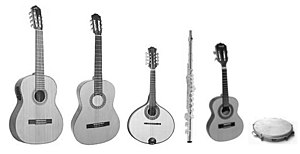Choro
The choro ( pronunciation : [ 'ʃoɾu ]) is an instrumental Brazilian music style that probably originated in Rio de Janeiro in the 1870s as a fusion of popular European music ( polka , waltz ) and the music of African slaves .
Origin of the term
There are three theories about the origin of the term choro :
- Choro is the Portuguese word for lament (chorar = to cry). The often melancholy melodies of the choro would explain how the music got this name.
- Xolo could have been the ancestor of the word choro ; Xolo was an African dance .
- Choro could be a reduction of the word Charamela for shawm ; in fact, early choros were often played by brass ensembles.
occupation
Traditionally, a choro group consists of one or two guitars , a cavaquinho , a pandeiro , various percussion instruments and any solo instruments - often flute , clarinet or mandolin ( bandolim ). The bass function was originally taken over by the ophicleide and, since the 1930s, often by a seven-string guitar ( violão de sete cordas ). There are now compositions for all kinds of instruments and line-ups, from piano to big band. There are also choros with singing, such as B. Tico-Tico no Fubá (The sparrow in the flour).
composition
Improvisations on the theme of the composition play an important role. Most chorus compositions are characterized by a relatively high tempo, a melody and rhythm structure based on 16th notes and the samba-typical phrasing in which these 16th notes are not played evenly but with a certain "egg". Due to the high tempo played melody lines from continuous 16th notes, great virtuosity is required of the musicians. And not just from the solo or melody instruments; The accompaniment also leans closely to the melody, goes along with the accentuation, supports and thus carries the melody. Often choruses are composed in the classical ABACA form. So there is a main theme followed by a second melody, then the first theme is repeated, followed by a third, and finally the first melody is repeated again. These three parts can vary greatly in rhythm and style.
The choro today
Since the advent of broadcasting in the 1920s, the importance of the chorus has declined. However, some musicians keep the tradition up and make it one of the most interesting musical styles in Brazil with its virtuosity. In Europe, however, this style of music is largely unknown.
From the mid-1930s, the choro disappeared almost completely and was only rediscovered in Brazil in the 1950s. At that time there was the first "Rodas do Choro". Musicians met - similar to a jam session - to supplement pieces from the classical choro repertoire with improvisations.
But it took almost another 50 years before choro became socially acceptable again. Today, choro is “in” not only in Rio or São Paulo, but also in New York and on the west coast of the USA. The first cautious Rodas are now also in Europe, especially in Paris, which is still a stronghold of Brazilian music in Europe. In October 2006 a Roda do Choro took place in Hamburg (in the Schanzenviertel) with the Camerata do Choro (conductor: Paulo Gouveia, flute) and guests from Brazil, including Wilfried Berk (Rio de Janeiro / Hanover) on the clarinet.
The film Brasileirinho (2005) by Mika Kaurismäki is not only about the music, the choro, but also about the people who play this music.
Important choro composers and performers
- Chiquinha Gonzaga (* 1847, † 1935)
- Joaquim Calado (* 1848, † 1880)
- Viriato Figueira (* 1851, † 1883)
- Juca Kalut (* 1858, † 1922)
- Satyro Bilhar (* 1860, † 1927)
- Ernesto Nazareth (* 1863, † 1934)
- Anacleto de Medeiros (* 1866, † 1907)
- Quincas Laranjeiras (* 1873, † 1935)
- Irineu de Almeida (* 1873, † 1916)
- Zequinha de Abreu (* 1880, † 1935)
- Patápio Silva (* 1880, † 1907)
- João Pernambuco (* 1883, † 1947)
- Tute (* 1886, † 1957)
- Pixinguinha (* 1897, † 1973)
- Luiz Americano (* 1900, † 1960)
- Benedito Lacerda (* 1903, † 1958)
- Luperce Miranda (* 1904, † 1977)
- Radamés Gnattali (* 1906, † 1988)
- Abel Ferreira (* 1915, † 1980)
- Garoto (* 1915, † 1955)
- K-Ximbinho (* 1917, † 1980)
- Jacob do Bandolim (* 1918, † 1969)
- Dino 7 Cordas (Horondino José da Silva) (* 1918, † 2006)
- Waldir Azevedo (* 1923, † 1980)
- Ademilde Fonseca (* 1921, † 2012)
- Luciana Rabello (* 1961)
- Raphael Rabello (* 1962, † 1995)
- Nilze Carvalho (* 1969)
- Wilfried Berk (* 1940)
